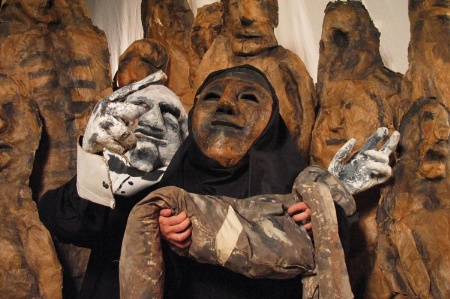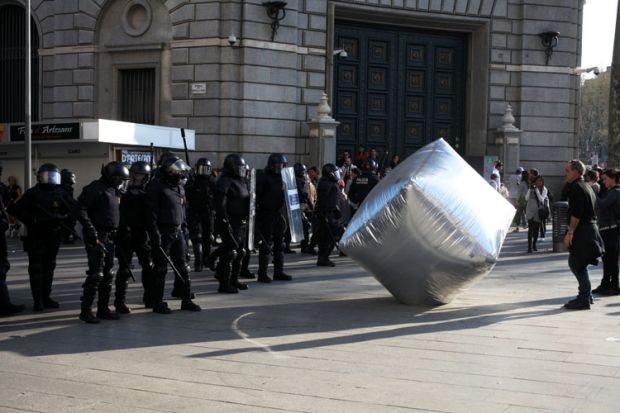Source: Oriana EliÇabe/Enmedio.info
Artefacts of dissent: the pieces on display range from the ‘tactile frivolity’ of a silver cube to the solemnity of textiles produced by Chilean women living under Pinochet
Disobedient Objects
Victoria and Albert Museum, London
Until 1 February 2015
The disobedience so eloquently expressed by the objects cannot help but prompt us to interrogate our own respectful obedience to the order of museums
I have always been a relatively dignified protester. My only indiscretion was the reckless abandonment of a battered placard in the Oxford Street John Lewis when I snuck out of a march to use the facilities. Temporarily parked amid innocuous rows of Egyptian cotton, Le Creuset pans and airtight Tupperware, its obstreperous message of opposition seemed somehow more audible in the serene fiefdom of a London department store – perhaps more than when it had been bobbing along in the sea of banners, whistles and loudspeakers that are so characteristic of modern protest.
This question of how one is heard, though, is posed more seriously at the Victoria and Albert Museum’s new exhibition, Disobedient Objects, which examines an array of dissenting campaigns, causes, marches and protests through the various devices deployed in their name. The approach is a smart one, providing a thoughtful new angle of entry into all the usual movements of collective social and political life. Feminism, anti-fascism, anticapitalism, workers’ rights, environmentalism, and local and global justice are all here, documented in provocative, often unexpected ways. But the exhibition takes special care to attend to more specific, often smaller causes whose resonances at particular moments have been as a tinderbox to a flame, marking the various crises of the modern era.
What makes this analysis of the history of protest through its objects so arresting is the diverse ways in which its materials are sourced: dissent is not just made of the stuff of placards or pamphlets, but recovered in the delicate bone-china tea sets of the Women’s Social and Political Union, who frequently smashed the windows of department stores; the hand-crafted “Trini” dolls complete with knitted balaclavas produced in endorsement of a favoured leader of the Zapatista Army of National Liberation in Mexico; and the huge, ludicrously cheerful, inflatable silver cube whose “tactical frivolity” was designed to baffle forces policing May Day demonstrations in Berlin in 2012.
The artefacts of dissent take all sorts of forms and, gathered together in this exhibition, plot a global narrative of change and conflict that identifies ours as an epoch peculiarly marked by the intersection of new technologies and complex political challenges. Disobedient Objects documents grass-roots social movements through the art and design of their expression, beginning from the premise that objects play key roles in social life. This is an explicitly politicised material history, but is in some ways not such a departure from the logic of any museum whose raison d’être is to discern, display and curate culture through objects. What is perhaps more remarkable is the shift in attention demanded by this particular exhibition, from the curation of elite objects of private consumption to democratic objects of public expression. If there is some tension in the juxtaposition of fine arts with the often hastily sourced, haphazard productions of global dissenters who work under the duress of their various causes and crises, then this only serves to point up the privileged conditions of elite aesthetic production and the obligation of any curational institution to extend the parameters of its cultural purview.
Indeed, Disobedient Objects makes a point of this, stridently reframing political activism as an imaginative process driven by design ingenuity and collective creativity. That is why the exhibition consists of such an anarchic miscellany of woven banners, campaign badges, guerrilla/gorilla masks, defaced currency, makeshift barricades, book-shaped blockades, polemical video games, experimental bicycles and even an inflatable general assembly apparently intended to facilitate impromptu “consensus decision-making”.

This is an exhibition that curates the objects of a material political history, but which equally instructs us to acknowledge the creativity of making in social movements. And indeed, this is creative making that is not without lightness alongside its serious intent, visible in the mischievous gender-bending doll-swapping antics of the “Barbie Liberation Organization”, the flashy Nike logo reduced to a homely knitting pattern by anti-globalisation campaigners, even a slogan emblazoned on a student’s anti-tuition-fee placard that impudently retorts to those in power, “I wish my boyfriend was as dirty as your policies.” More soberly, the brightly appliquéd textiles produced by Chilean women living under the Pinochet regime are indicative of the kind of subterfuges required to enable dissent in some circumstances. Traditionally gentle folk arts are quietly subverted to depict scenes of horror: weeping mothers, chained hands, falling doves and the penetrating eyes of the secret police. The panels generated income and solidarity for the women in a period of scrutiny and oppression, but, crucially, they also provided an absorbing activity: “when their hands and eyes were focused on sewing, they felt safe enough to speak and share their lives”. Such textiles possess a careful beauty.
Beauty, though, is also a danger here, however carefully navigated. The salubrious environs of the V&A cannot help but sanitise much of this material, running the risk of parading politics as art outside of its context. The gorgeous green hand-painted Karnataka State Farmers’ Association (KRRS) sign declares the autonomy of millions of south-west Indian villagers, defiant in the face of intrusive governments, asset-seizing banks and GM crop proponents. But far away from the village to which it belongs, the power of its painstakingly white cursive Kannada script is muted, the sign inevitably more decorative than demonstrative.
And yet it is to the credit of this exhibition that it acknowledges the invariable abeyance in which these “disobedient objects” are held, subjected as they are to the institutional conventions of a curatorial space. To be displayed in a museum may no longer be to be preserved in aspic, particularly as galleries develop increasingly elaborate modes of interactivity – here, you are invited variously to plug into video installations, download an anti-corporation app, produce your own defaced currency and imagine your own disobedient object, for instance – but the injunction not to touch remains a tacit condition of the relationship of spectator to artefact. The disobedience so eloquently expressed by the objects cannot help but prompt us to interrogate our own respectful obedience to the order of museums. How we square this contradiction of the subject matter and space of this exhibition remains a question, and one the V&A reflects upon, conceding in the catalogue that the material has forced its hand, so that “rules concerning plinths, barriers, and touching distances have been revised”.
The museum has also made efforts to address issues of access, obedience and proximity. The collection is rightly free to visit, several of the displays invite visitor involvement, and the exhibition itself is set on a stripped stage with makeshift plywood barriers and blockades in various places. There is something profoundly affecting in the fact of the blockade, somehow bought home in this curious space. It is that most basic act of building: one erects a shelter, a sanctuary, a shield to protect, defend or hold at bay. A blockade is itself a stark physical representation of the divisions of political and moral difference. So many of the objects in this collection have been confiscated or were at risk of confiscation, and many remain courageously defiant in the face of that. In curating them here at the V&A, the museum carves out a space in which they are cared for, even cherished.
Register to continue
Why register?
- Registration is free and only takes a moment
- Once registered, you can read 3 articles a month
- Sign up for our newsletter
Subscribe
Or subscribe for unlimited access to:
- Unlimited access to news, views, insights & reviews
- Digital editions
- Digital access to THE’s university and college rankings analysis
Already registered or a current subscriber? Login

